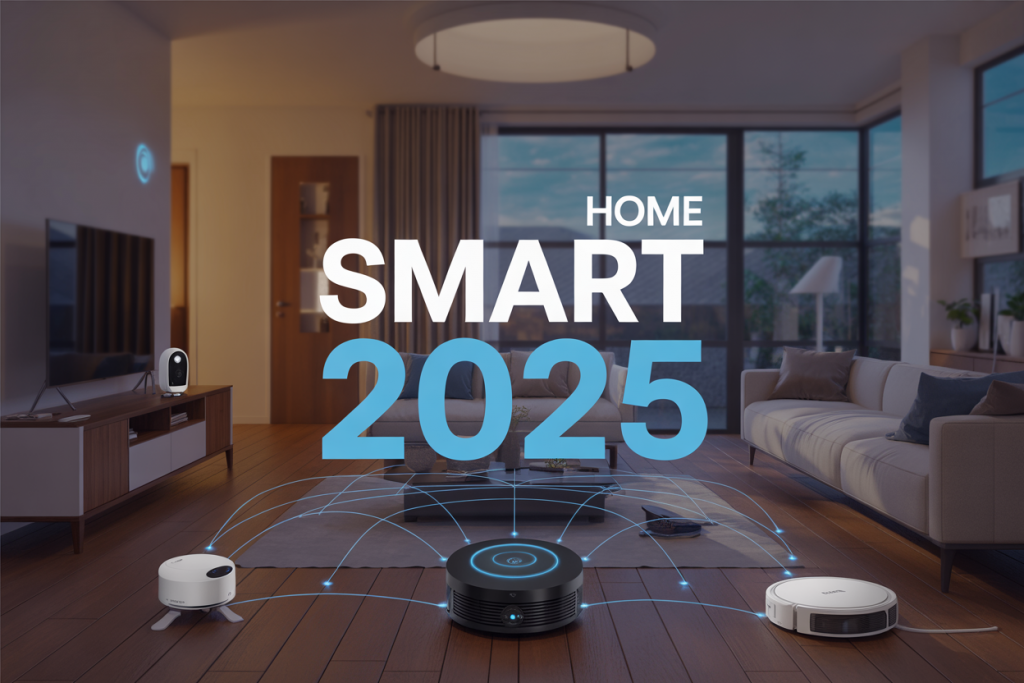Your home is about to get a major upgrade. Smart gadgets 2025 brings cutting-edge devices that actually make daily life easier, safer, and more efficient. This guide is perfect for homeowners, renters, and tech enthusiasts who want to create a connected living space without the guesswork.
The smart home technology landscape has exploded with practical solutions that work together seamlessly. From AI-powered security cameras that recognize familiar faces to voice-controlled systems that manage your entire home, these aren’t just cool gadgets—they’re game-changers for how you live.
We’ll walk you through advanced smart security systems that protect your home 24/7, essential control centers that become the brain of your smart home ecosystem, and automated solutions for cleaning and kitchen tasks that save hours each week. You’ll also discover which devices offer the best bang for your buck and how to build a system that grows with your needs.
Ready to transform your space into the smart home of the future? Let’s dive into the must-have devices that will revolutionize your daily routine.
Advanced Smart Security Systems to Safeguard Your Entire Home
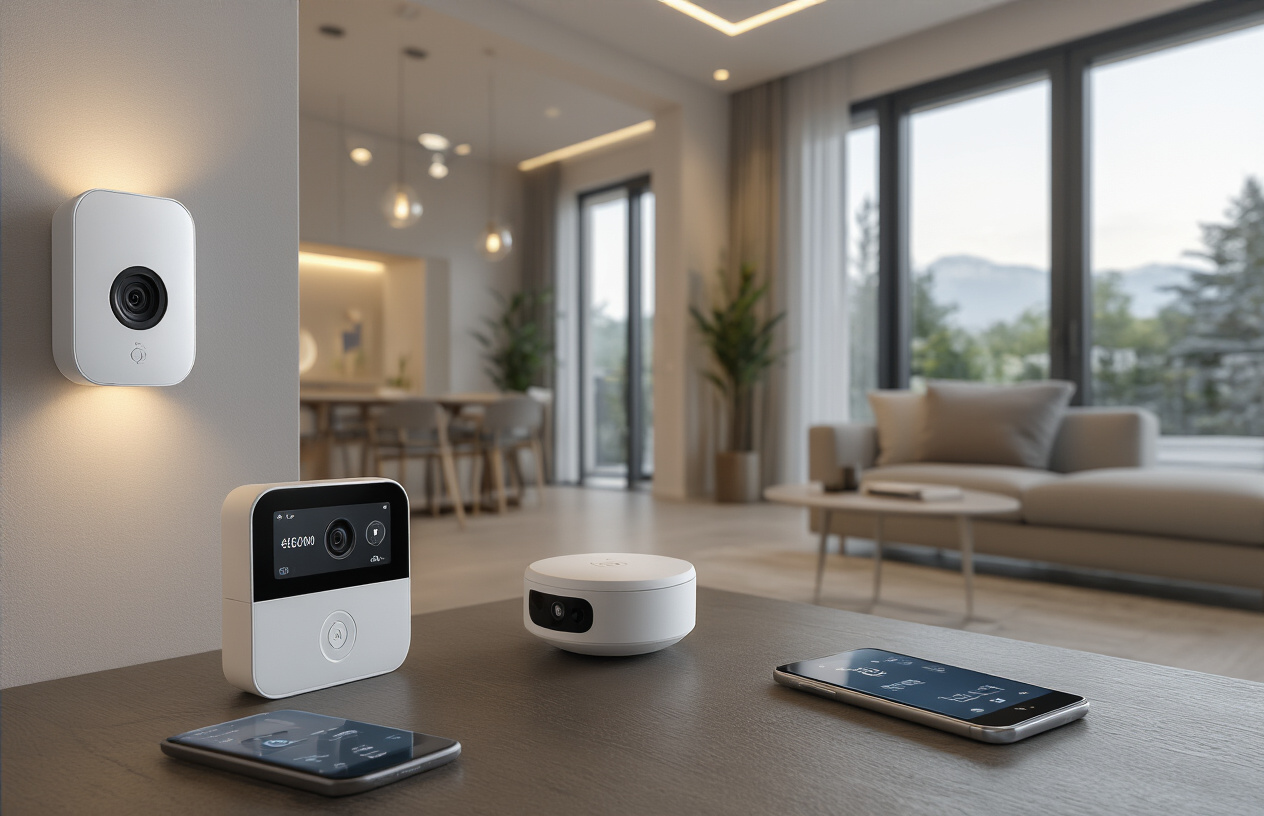
Advanced Smart Security Systems to Safeguard Your Entire Home
Modern smart security systems have revolutionized home protection, offering comprehensive solutions that integrate seamlessly with your smart home ecosystem. These advanced systems provide peace of mind through cutting-edge technology and 24/7 monitoring capabilities.
Advanced Security Cameras with AI Motion Detection
The Aqara Camera Hub G5 Pro represents the pinnacle of smart security camera technology, delivering high-resolution video quality with weather-resistant construction. This advanced camera features sharp video recording capabilities, enhanced color night vision, and sophisticated AI-powered motion detection that distinguishes between different types of movement and potential threats.
Smart security cameras now offer 4K video recording capabilities, ensuring crystal-clear footage for identification purposes. The integration of night vision technology means your home remains protected even in complete darkness. AI-powered motion detection eliminates false alerts by intelligently analyzing movement patterns and distinguishing between pets, people, and vehicles. These cameras integrate seamlessly with doorbell systems and smart locks, creating a comprehensive home security solution that works together as a unified system. Cloud storage options ensure your footage is safely backed up, while app alerts keep you informed of any activity in real-time.
Smart Video Doorbells for Enhanced Visitor Management
The Arlo Video Doorbell (2nd Generation) exemplifies the latest in visitor management technology, offering HD or 2K video quality with an impressive 180-degree field of view. This versatile device accommodates both wired and wireless installation options and supports convenient voice control functionality.
Smart video doorbells transform how homeowners interact with visitors, allowing them to see and communicate with anyone at their door from anywhere in the world. Advanced features include sophisticated package detection capabilities that alert you when deliveries arrive, facial recognition technology that can identify familiar faces, and customizable motion alerts that notify you of any activity at your entrance. These devices serve as the first line of defense in your smart security systems, providing both convenience and security enhancement.
Keyless Smart Locks with Multiple Access Options
The Ultraloq U-Bolt Pro Wi-Fi Smart Lock demonstrates the versatility of modern smart locks, supporting multiple access methods including fingerprint recognition, keypad entry, smartphone app control, and voice commands. Its integration with HomeKit ensures compatibility with Apple’s smart home ecosystem.
Smart locks provide ultimate convenience through keyless entry systems that eliminate the need for traditional keys. Remote access capabilities allow homeowners to lock or unlock their doors from anywhere, while guest passcode features enable temporary access for visitors, service providers, or rental guests. These devices integrate seamlessly with other smart home devices, creating enhanced security protocols where doors can be automatically locked when you leave or unlocked when you arrive. Voice command compatibility with popular assistants adds another layer of convenience to your daily routine.
Professional Monitoring Systems for 24/7 Security
Professional monitoring takes smart security systems to the next level with round-the-clock surveillance and response capabilities. ADT Command offers a comprehensive professionally monitored security system that provides constant vigilance over your property. Vivint Smart Home delivers advanced security features combined with monthly monitoring services, ensuring immediate response to any security breaches.
For those preferring a do-it-yourself approach, SimpliSafe Home Security System provides professional-grade security with DIY setup capabilities, offering remote security monitoring without the complexity of professional installation. These systems combine the convenience of smart home technology with the reliability of professional security monitoring, creating a comprehensive protection strategy for your smart living space.
Essential Smart Home Control Centers
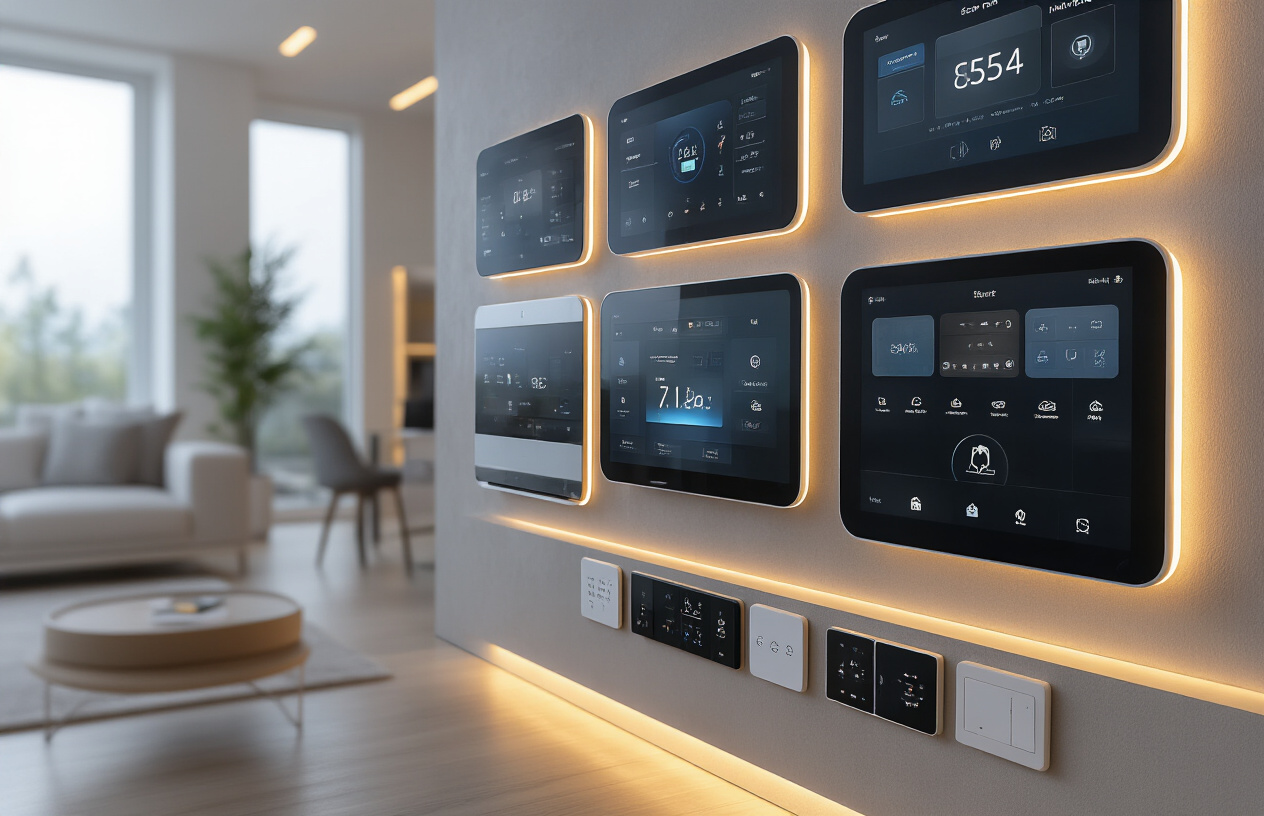
Essential Smart Home Control Centers
Now that we’ve explored advanced security systems for your home, let’s delve into the heart of any smart home ecosystem: the control centers that orchestrate your entire connected living space. These smart home devices serve as the command headquarters for managing your home automation systems seamlessly.
Smart Speakers and Displays as Central Command Hubs
Smart speakers and displays like the Amazon Echo Show 10 and Google Nest Hub Max have evolved into powerful central hubs for controlling other smart home devices throughout your living space. These smart gadgets 2025 offerings go far beyond simple voice commands, providing comprehensive visual displays that enhance the entire user experience.
The visual interface capabilities of these devices make them indispensable for modern smart home technology. They deliver crystal-clear displays for video calls, allowing you to connect with family and friends while managing your home simultaneously. The screens also provide step-by-step recipe instructions in the kitchen, transforming cooking experiences with hands-free guidance. Perhaps most importantly, these control centers offer real-time security camera feeds, giving you instant visual access to monitor your home’s safety from any room.
Smart Home Hubs for Seamless Device Integration
With this comprehensive control foundation in place, smart home hubs such as Samsung SmartThings or Hubitat Elevation ensure seamless integration across different brands and protocols within your connected home devices ecosystem. These sophisticated hubs eliminate the common frustration of incompatible devices by serving as universal translators for your IoT home gadgets.
The centralized control architecture these hubs provide makes home automation 2025 systems significantly more reliable and easier to manage. Rather than juggling multiple apps and interfaces, you gain a unified platform that coordinates all your smart devices effortlessly. This integration capability proves essential as your smart home ecosystem grows, ensuring that new additions work harmoniously with existing components.
Voice Control Integration Across All Devices
Previously, I’ve highlighted the importance of centralized hubs, and now voice control integration with smart speakers and displays takes convenience to the next level, making managing your entire home effortless through simple verbal commands. This hands-free approach to smart living space management represents the pinnacle of user-friendly home automation systems.
Specific devices like the Arlo Video Doorbell and Ultraloq U-Bolt Pro Smart Lock exemplify this seamless voice control integration. These advanced smart home devices respond instantly to voice commands through your central control hubs, allowing you to unlock doors, check visitor identity, and manage access without physical interaction.
Smart locks and smart lighting systems further demonstrate the power of voice control integration, enabling you to adjust ambiance, secure your home, and manage energy consumption through natural speech patterns. This comprehensive voice control ecosystem transforms daily routines into effortless experiences.
Energy-Efficient Climate and Lighting Systems
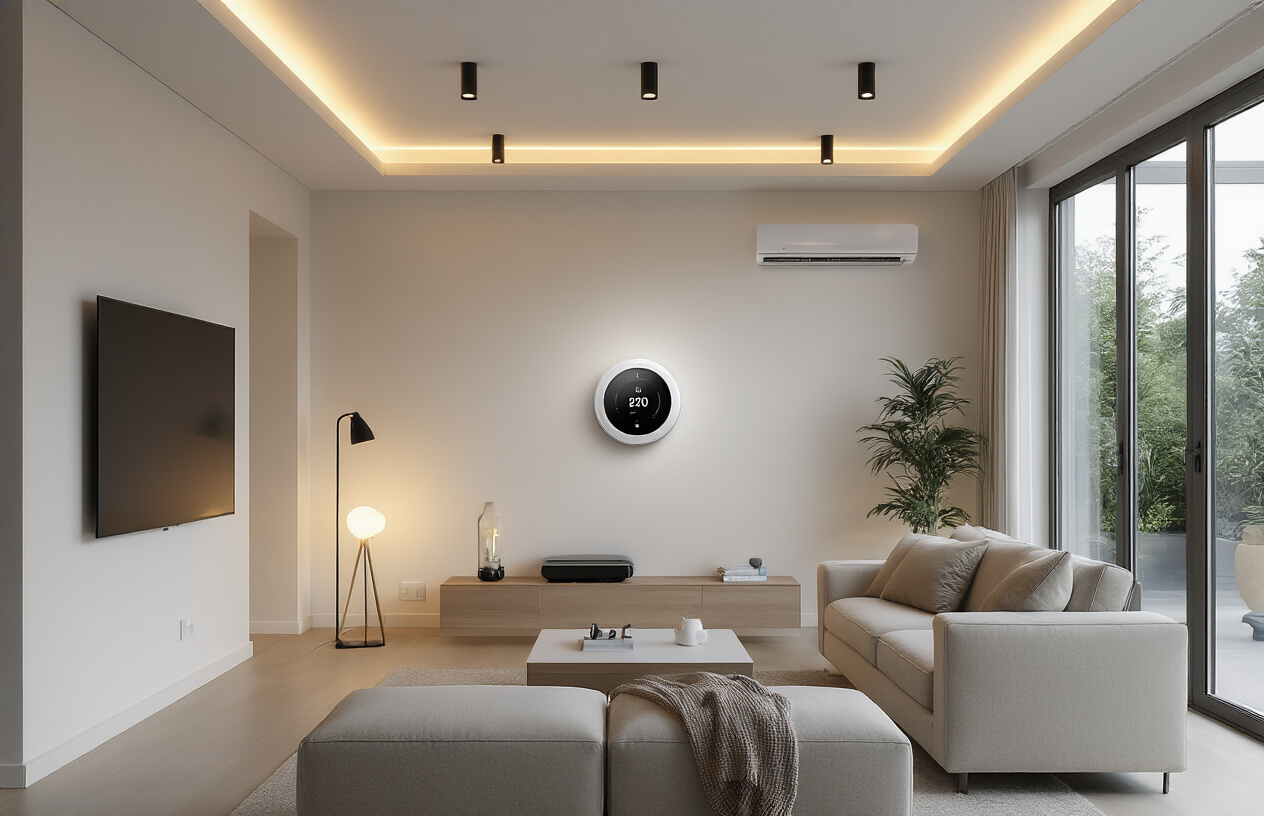
Energy-Efficient Climate and Lighting Systems
Now that we’ve explored essential smart home control centers, let’s delve into the smart gadgets 2025 that will revolutionize how you manage energy consumption while maintaining optimal comfort in your living space. These connected home devices represent the cutting edge of home automation systems designed to reduce your environmental footprint without compromising on convenience.
Smart Thermostats That Learn Your Schedule
Smart thermostats have emerged as cornerstone devices in any smart home ecosystem, with models like the Google Nest Learning Thermostat and Ecobee SmartThermostat leading the charge in intelligent climate control. These sophisticated smart home devices go beyond basic temperature adjustment by learning your daily routines and preferences over time.
The learning capability sets these smart gadgets 2025 apart from traditional thermostats. They automatically adjust temperatures based on your schedule, ensuring your home is comfortable when you’re present while conserving energy when you’re away. Remote control functionality allows you to manage your home’s climate from anywhere using your smartphone, providing unprecedented flexibility in home automation 2025.
Perhaps most importantly, these IoT home gadgets deliver tangible benefits to your energy bills. By optimizing heating and cooling cycles based on occupancy patterns and external weather conditions, smart thermostats can significantly reduce energy consumption while maintaining consistent comfort levels throughout your living space.
Intelligent Lighting Systems for Mood and Efficiency
Smart lighting technology has evolved dramatically, with systems like Philips Hue and LIFX transforming how we illuminate our homes. These intelligent lighting solutions offer comprehensive control over brightness levels, color temperature, and scheduling through smartphone applications or voice commands, making them essential components of modern smart home technology.
The versatility of these smart living space solutions extends far beyond basic on/off functionality. You can create customized mood lighting for different occasions, whether you’re hosting a dinner party, relaxing after work, or focusing on productivity tasks. The ability to adjust color temperature throughout the day can even support your natural circadian rhythms.
Energy efficiency remains a primary advantage of these connected home devices. Automated scheduling ensures lights turn on and off at predetermined times, eliminating energy waste from forgotten lights. The precision control over brightness levels means you use only the illumination you need, further contributing to energy savings while enhancing your home’s ambiance.
Smart Plugs and Power Strips for Energy Monitoring
Smart plugs represent an accessible entry point into home automation systems, with devices like TP-Link Kasa and Wemo Mini transforming ordinary appliances into smart-enabled devices. These compact smart home devices plug into existing outlets, instantly adding remote control, scheduling capabilities, and energy monitoring to any connected appliance.
The scheduling functionality allows you to automate device operation, turning appliances on and off at specific times without manual intervention. This automation extends the smart home ecosystem to devices that weren’t originally designed with connectivity in mind, from coffee makers to table lamps.
A significant trend for 2025 involves enhanced energy monitoring capabilities in these IoT home gadgets. Modern smart plugs and power strips track and report detailed energy usage data, providing insights into which appliances consume the most power. This information empowers homeowners to make informed, eco-friendly choices about their energy consumption patterns, supporting both environmental goals and cost savings. The real-time monitoring helps identify energy-hungry devices and optimize usage patterns for maximum efficiency.
Automated Cleaning and Kitchen Solutions
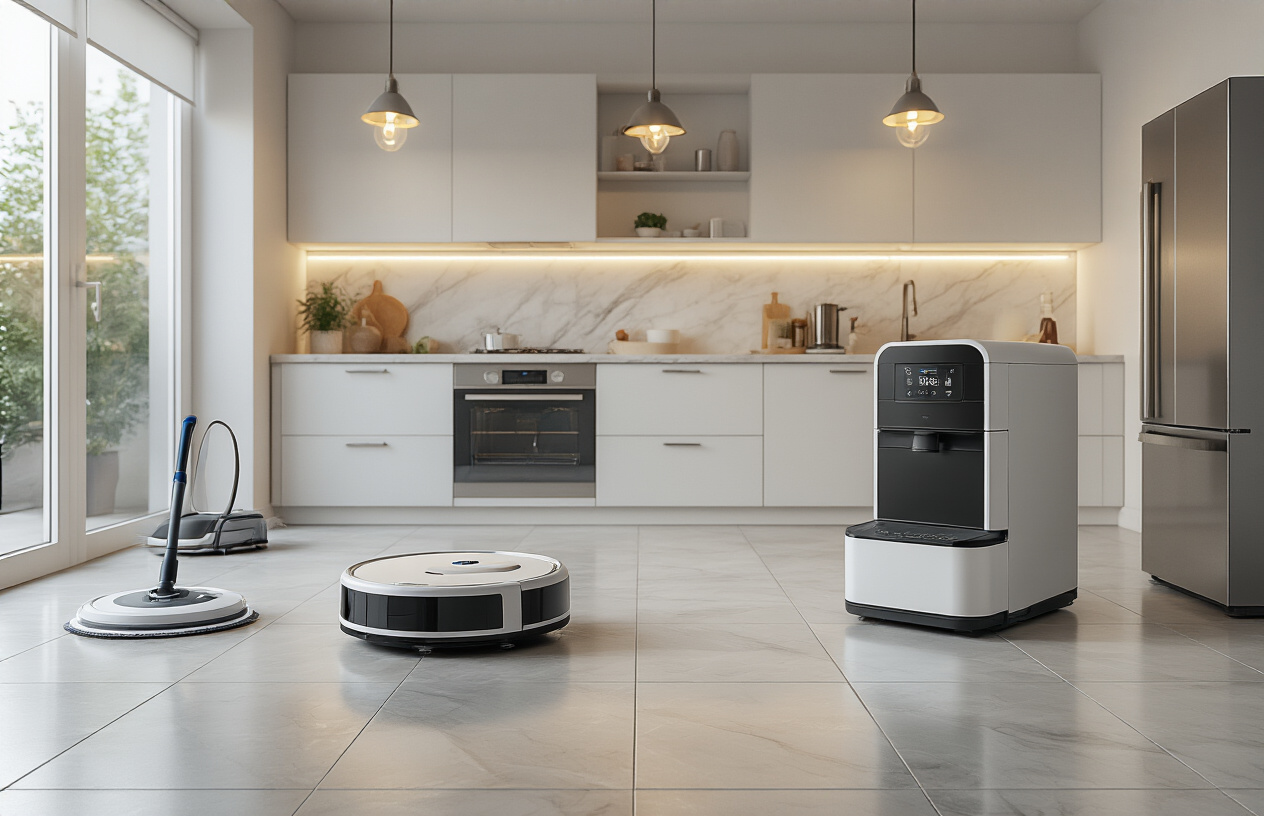
Automated Cleaning and Kitchen Solutions
Now that we have covered the essential control centers and climate systems, let’s explore how smart gadgets 2025 can revolutionize your daily cleaning routines and culinary experiences through intelligent automation.
AI-Powered Robot Vacuums with Self-Emptying Features
The latest generation of robot vacuums represents a significant leap forward in home automation systems. Leading models like the iRobot Roomba j9+ and Roborock S8 Max showcase the pinnacle of smart home technology with their sophisticated AI mapping capabilities and advanced obstacle avoidance systems.
These connected home devices eliminate the tedious task of manual vacuuming by maintaining your floors without any intervention. The self-empty bins feature ensures weeks of hands-off operation, automatically disposing of collected debris into larger base stations. The AI mapping technology creates detailed floor plans of your living space, enabling these smart home devices to navigate efficiently around furniture and obstacles.
What sets these IoT home gadgets apart is their seamless integration with broader home automation 2025 ecosystems. You can schedule cleaning sessions remotely, coordinate with other smart devices, and even set up automated routines that trigger cleaning cycles when you leave home.
Smart Kitchen Appliances for Meal Preparation
Revolutionary cooking solutions are transforming modern kitchens through intelligent connectivity and remote control capabilities. The Instant Pot Smart Wi-Fi exemplifies how smart living space technology brings unprecedented convenience to meal preparation.
These innovative appliances can be controlled remotely through smartphone applications, allowing you to start cooking processes while away from home. The built-in cooking guidance systems provide step-by-step instructions and automated cooking programs, making complex recipes accessible to home cooks of all skill levels.
Connected Refrigerators for Inventory Management
Connected refrigerators like the Samsung Family Hub Refrigerator represent the future of smart home ecosystem integration in kitchen management. These sophisticated appliances go far beyond simple food storage, offering comprehensive inventory tracking and grocery management capabilities.
The remote control functionality allows you to monitor your refrigerator’s contents from anywhere, helping you make informed shopping decisions and reduce food waste. The inventory management features automatically track expiration dates and suggest meal ideas based on available ingredients, streamlining your entire culinary workflow within your smart home technology setup.
Advanced Smart Features Transforming Modern Living
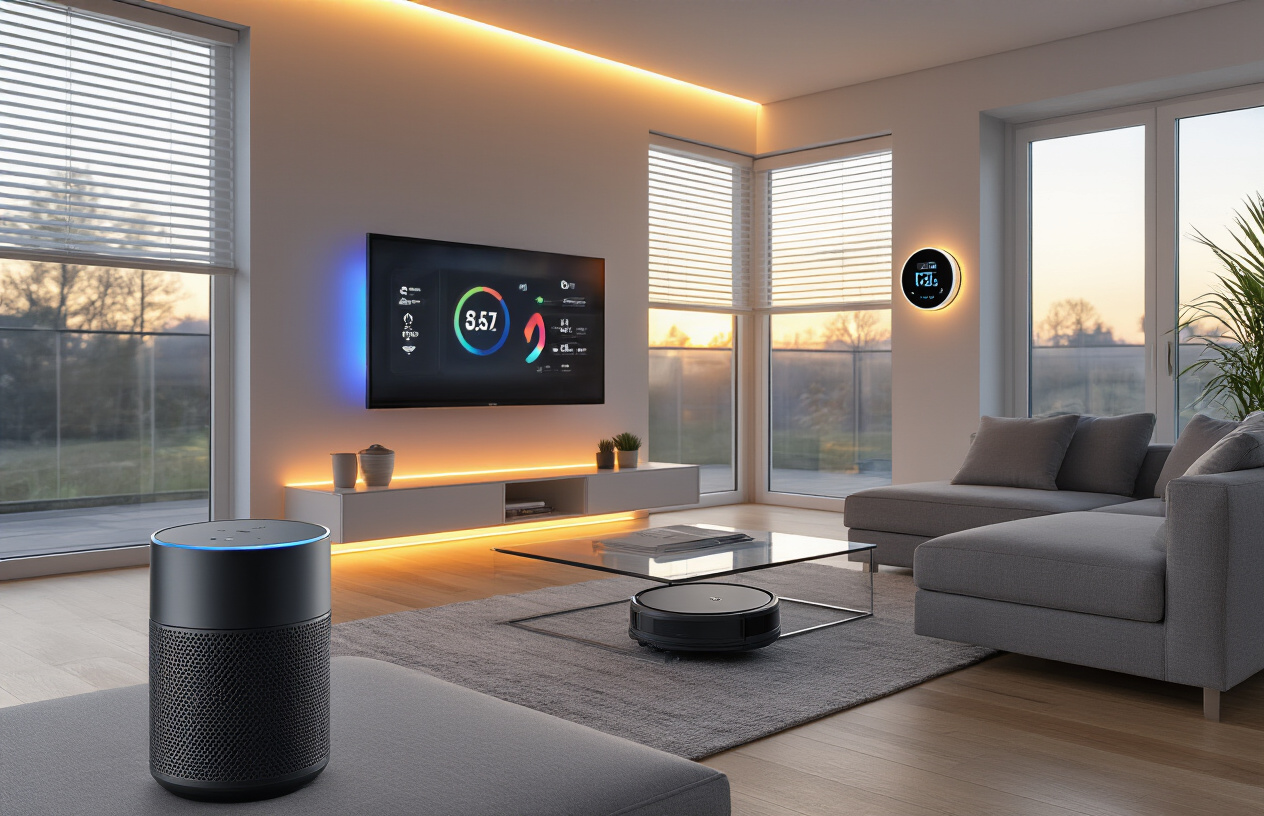
Advanced Smart Features Transforming Modern Living
Now that we have covered the essential foundation elements of smart home automation systems, let’s explore the cutting-edge features that are truly revolutionizing how we interact with our living spaces in 2025. These advanced smart gadgets 2025 technologies represent the pinnacle of home automation innovation, offering unprecedented levels of control, compatibility, and intelligence.
Smart Glass Technology for Privacy Control
Smart glass technology represents one of the most impressive innovations in connected home devices, offering homeowners dynamic control over privacy and natural light. The Feather River Doors Smart Glass exemplifies this revolutionary technology, featuring the ability to switch between opaque and transparent states seamlessly. This transformation can be controlled through voice commands or a simple push button, providing instant privacy control without the need for traditional window treatments.
This smart home technology eliminates the compromise between natural light and privacy that homeowners have faced for decades. Whether you need privacy for a home office meeting or want to open up your space with transparent glass, the control is literally at your fingertips. The integration capabilities make it compatible with existing home automation systems, allowing users to program automatic privacy settings based on time of day or specific scenarios.
Cross-Platform Compatibility with Matter Protocol
The smart home ecosystem has evolved significantly with the introduction of the Matter protocol, addressing one of the biggest challenges in home automation 2025: device compatibility. The Aqara Camera Hub G5 Pro demonstrates this advancement by supporting Matter, Thread, and Zigbee protocols simultaneously, creating a truly unified smart living space experience.
This increased focus on the Matter protocol represents a game-changing development for IoT home gadgets, as it allows devices from different manufacturers to work together seamlessly. Previously, homeowners faced the frustration of incompatible devices that couldn’t communicate effectively. With Matter protocol integration, your smart home devices can now operate as a cohesive unit, regardless of brand differences, creating a more reliable and user-friendly smart home technology environment.
AI Integration for Proactive Home Management
The integration of artificial intelligence marks the evolution from reactive to proactive home automation systems. Modern AI integration enables devices to anticipate user needs and make automatic adjustments without manual intervention, transforming the concept of smart living space management.
AI-powered motion detection in security cameras represents a significant leap forward, providing more accurate threat assessment and reducing false alarms. Similarly, AI mapping technology in robot vacuums creates more efficient cleaning patterns, learning your home’s layout and optimizing routes for maximum coverage. This proactive approach to home automation 2025 means your smart home ecosystem becomes more intelligent over time, continuously learning and adapting to your lifestyle patterns for enhanced convenience and efficiency.
Key Considerations for Building Your Smart Home Ecosystem
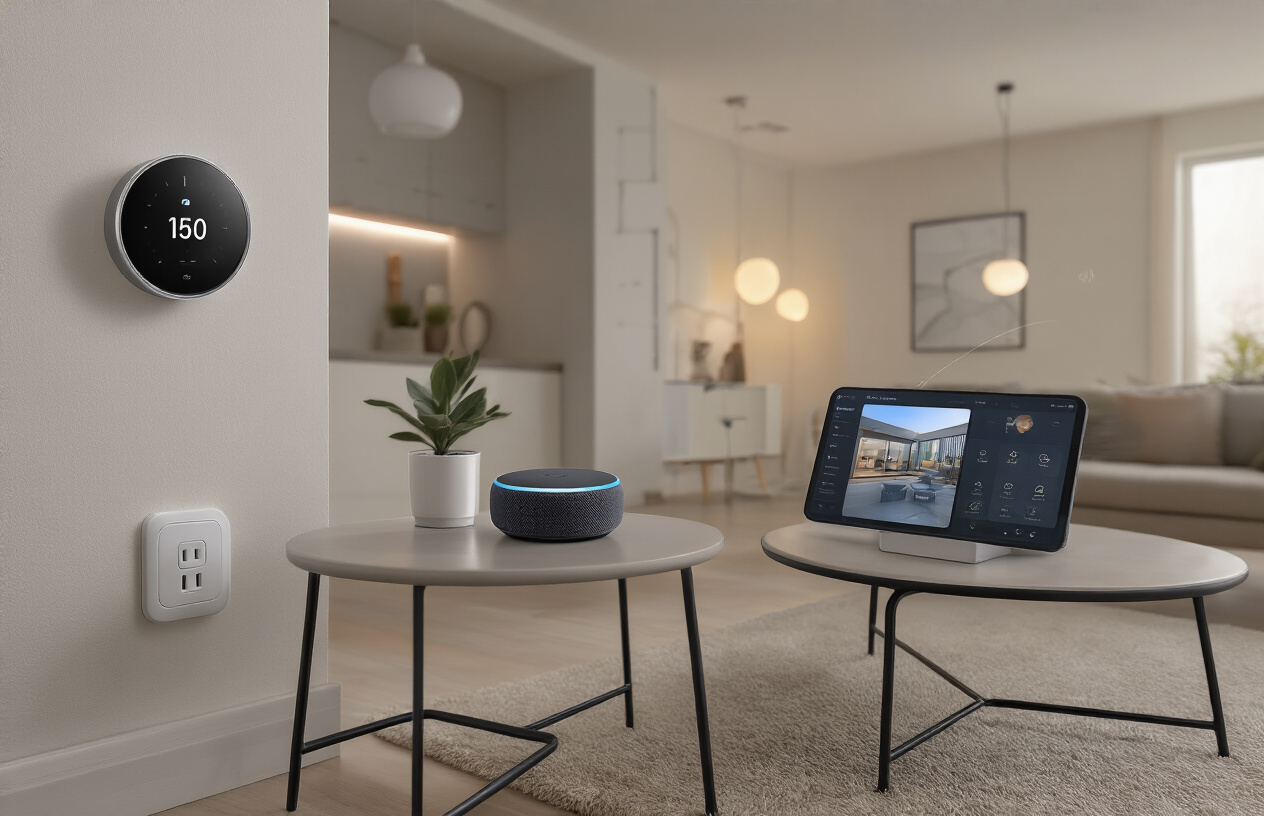
Key Considerations for Building Your Smart Home Ecosystem
Now that we’ve explored the essential smart gadgets that can transform your living space in 2025, it’s crucial to understand the strategic approach needed to create a cohesive and efficient smart home ecosystem. Building a successful connected home requires careful planning and consideration of several key factors that will determine both your immediate satisfaction and long-term success with home automation systems.
Compatibility Assessment with Major Platforms
The foundation of any successful smart home ecosystem lies in choosing devices that integrate seamlessly with your preferred platform. When selecting smart gadgets 2025, you’ll need to assess compatibility by choosing devices that work well with established ecosystems like Amazon Alexa, Google Home, or Apple HomeKit. Each platform offers unique advantages and limitations, making it essential to align your device selections with your chosen ecosystem from the start.
Before investing in any smart home devices, determine which platform best suits your existing technology preferences and usage patterns. This strategic approach ensures that your IoT home gadgets can communicate effectively with each other, creating the seamless automation experience that defines modern smart living spaces.
Prioritizing Devices Based on Lifestyle Impact
With countless connected home devices available, prioritizing your investments becomes crucial for maximizing value and satisfaction. Focus on areas that will make the biggest impact on your lifestyle, such as security, energy savings, or convenience. This targeted approach helps you build a smart home technology foundation that addresses your most pressing needs first.
Consider which aspects of your daily routine would benefit most from automation. Whether it’s enhancing security with smart security systems, reducing energy costs through intelligent climate control, or simplifying daily tasks with automated solutions, prioritizing based on lifestyle impact ensures your smart home ecosystem delivers meaningful improvements to your quality of life.
Scalability Planning for Future Expansion
Building a smart home ecosystem is an evolutionary process that benefits from thoughtful scalability planning. Consider scalability by starting with essential devices and expanding your smart home over time. This approach allows you to spread costs across multiple budget cycles while learning how each device integrates into your lifestyle before adding complexity.
When planning for future expansion, choose initial devices that serve as strong foundation points for your home automation 2025 goals. This strategic approach prevents technology conflicts and ensures that each new addition enhances rather than complicates your existing setup.
Security Features and Regular Update Support
As smart home technology becomes more sophisticated, security considerations become increasingly critical. Enhanced security features like multi-factor authentication and encrypted communications are now standard for protecting user data across your smart home ecosystem. These features are essential for maintaining privacy and preventing unauthorized access to your connected devices.
When evaluating potential devices, select products with a track record of regular firmware updates to keep features current and security protocols up-to-date. This ongoing support ensures your smart home devices remain protected against emerging threats while continuing to receive new features and improvements that enhance their functionality over time.
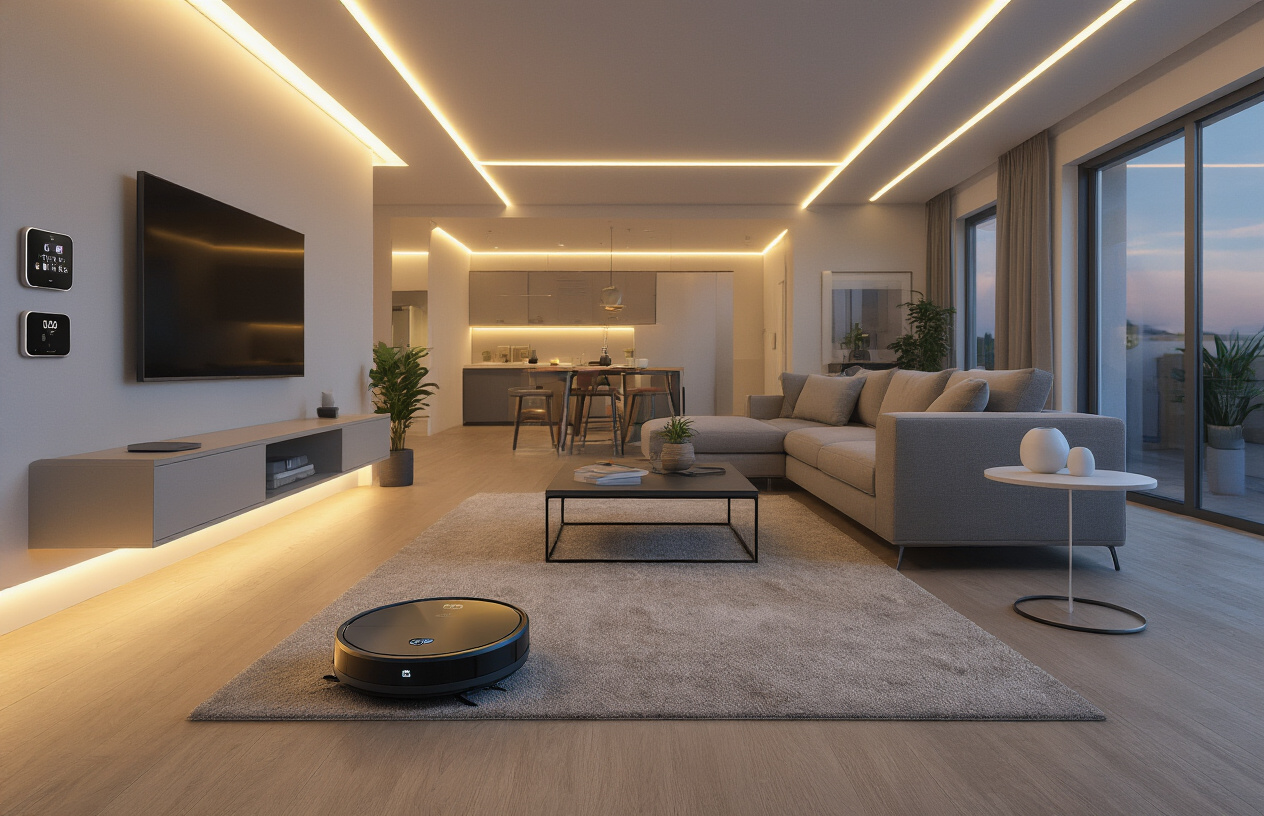
The smart home landscape in 2025 offers unprecedented opportunities to transform your living space into an intelligent, efficient, and secure environment. From advanced security systems like the Aqara Camera Hub G5 Pro and comprehensive monitoring solutions to essential control centers that serve as the brain of your home, these technologies work together to create seamless automation. Energy-efficient climate and lighting systems help reduce costs while maintaining comfort, while automated cleaning solutions and smart kitchen appliances free up valuable time for what matters most.
Building a successful smart home ecosystem requires careful consideration of compatibility, scalability, and your specific needs. Whether you start with budget-friendly smart plugs or invest in comprehensive security systems, the key is choosing devices that integrate well with your preferred platform and can grow with your lifestyle. With AI integration becoming more sophisticated and cross-platform compatibility improving through protocols like Matter, 2025 is the perfect time to embrace the smart home revolution and create a living space that truly works for you.
